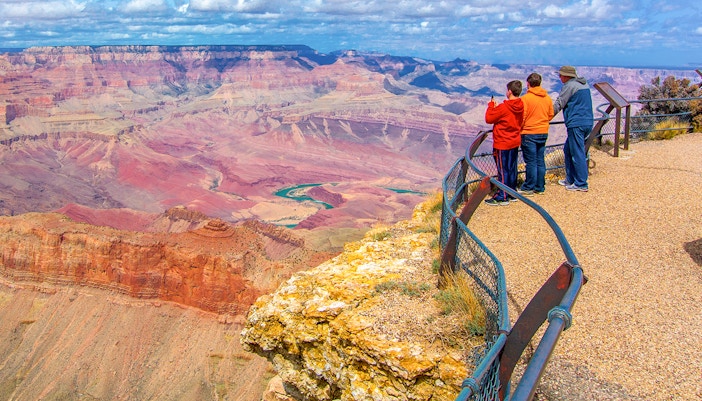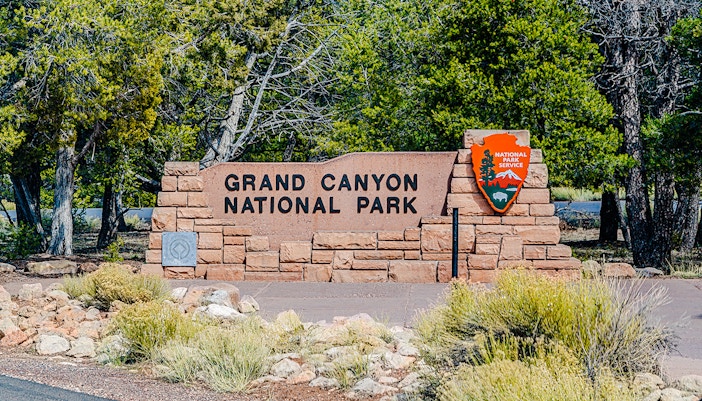
- North Rim
- History
- West Rim
- Grand Canyon National Park
- Grand Canyon
- Facts
- Grand Canyon Railway
- Hualapai Tribe
- South Rim
- Wildlife
- Shoshone Point
- Yavapai Geology Museum
- Hermit's Rest
- Hopi House
- Plan Your Visit
- Timings
- Directions
- Entrances
- Restaurants
- Map
- Camping
- Grand Canyon Village
- Weather
- Photos
- Hiking
- Things to Do
- Viewpoints
- Shopping
- Itinerary
- Hotels
- Rim to Rim
- Grand Canyon Floor Landing Tours
- Grand Canyon Lake Mead Tours
- Grand Canyon West Rim Tours
- Grand Canyon National Park Tours
- Grand Canyon North Rim Tours
- Las Vegas to Grand Canyon Helicopter Tours
- Grand Canyon Tours from Las Vegas
- Grand Canyon Airplane Tours
- Grand Canyon Helicopter Tours
- Grand Canyon South Rim Tours
- Grand Canyon Boat Tours
- West Rim Skywalk
- Grand Canyon National Park Helicopter Tours
- Grand Canyon Hummer Tours
- Grand Canyon West Rim Helicopter Tours
- Grand Canyon Tours
- Helicopter Tour Operators
A comprehensive guide to the Grand Canyon weather
Overview: Best time to visit the Grand Canyon
Seasons in the Grand Canyon

🌸 Spring (March–May)
Average temperatures:
- March: South Rim 51°F / 25°F (11°C / -4°C)
- April: South Rim 60°F / 32°F (15°C / 0°C)
- May: South Rim 70°F / 39°F (21°C / 4°C)
(Inner Canyon is ~20°F warmer)
Spring brings ideal hiking weather and the reopening of seasonal services. Snow begins to melt on the South Rim, trails become accessible, and wildflowers bloom across the canyon’s plateaus. The North Rim remains closed until mid-May, but the South Rim and Inner Canyon are excellent for early-season adventures.
Things to do:
- Hike the Bright Angel or South Kaibab Trails
- Attend a free ranger program at the South Rim
- Spot blooming desert flowers along rim trails
- Visit Havasu Falls (permit required)
- Take a mule ride along the Bright Angel Trail

☀️ Summer (June–August)
Average temperatures:
- June: South Rim 81°F / 47°F (27°C / 8°C)
- July: South Rim 84°F / 54°F (29°C / 12°C)
- August: South Rim 81°F / 53°F (27°C / 12°C)
(Inner Canyon 100–110°F / 38–43°C+)
Summer is the most popular season, but also the hottest, especially below the rim. Afternoon monsoons often arrive in July and August, bringing short but intense thunderstorms. Visitors flock to the North Rim for its cooler, forested trails. Early morning is the best time for hiking or photography.
Things to do:
- Watch the sunrise from Mather Point or Yaki Point
- Drive to Cape Royal or Point Imperial (North Rim)
- Raft the Colorado River (whitewater season)
- Enjoy a ranger talk or stargazing session
- Take the scenic Hermit Road shuttle at sunset

🍂 Fall (September–November)
Average temperatures:
- September: South Rim 75°F / 47°F (24°C / 8°C)
- October: South Rim 64°F / 36°F (18°C / 2°C)
- November: South Rim 52°F / 27°F (11°C / -3°C)
(North Rim closes mid-October)
Fall offers crisp air, golden aspens, and quieter trails. It's one of the best times for hiking and photography. The North Rim closes in mid-October due to snow risk, but the South Rim remains accessible and vibrant through November.
Things to do:
- Hike to Indian Garden or Plateau Point
- Capture fall foliage at the North Rim
- Visit Desert View Watchtower before it closes for winter
- Spot elk and mule deer along the rim
- Enjoy fewer crowds and cooler hikes
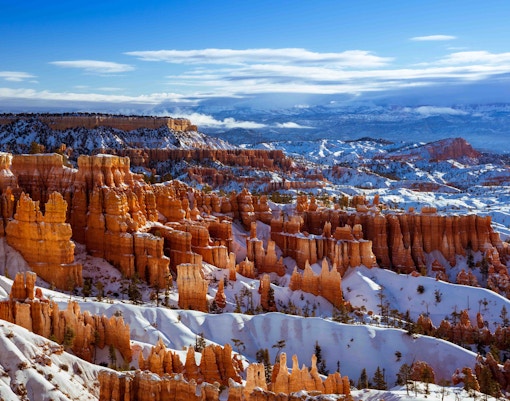
❄️ Winter (December–February)
Average temperatures:
- December: South Rim 43°F / 20°F (6°C / -6°C)
- January: South Rim 41°F / 18°F (5°C / -8°C)
- February: South Rim 45°F / 21°F (7°C / -6°C)
(North Rim closed; Inner Canyon remains mild)
Winter transforms the Grand Canyon into a peaceful, snow-dusted wonderland. The South Rim is open year-round and much quieter. Snowfall enhances photography, and lodging is easier to find. However, trails may be icy, and some roads can close temporarily after storms.
Things to do:
- Watch the sunrise over a snow-covered canyon
- Take winter hikes with crampons or traction cleats
- Explore the geology museum or the Visitor Center
- Enjoy a warm meal at El Tovar Lodge
- Photograph dramatic snow and cloud inversions
Month-by-month guide to the Grand Canyon
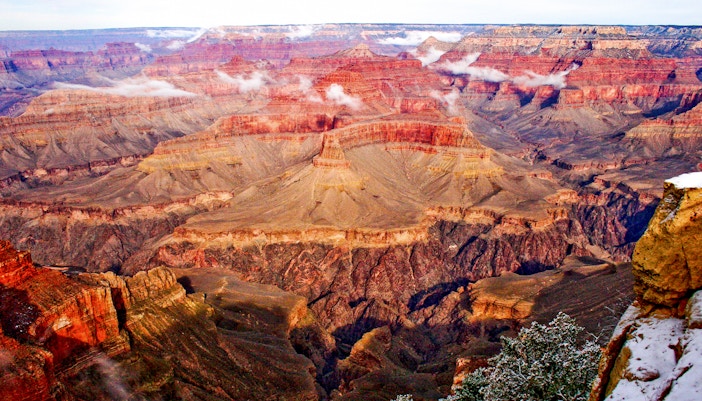
January
Average temperature: 41°F / 18°F (5°C / -8°C)
Average snowfall: 9 inches (23 cm)
January is quiet and peaceful at the South Rim. Expect snow-dusted views, clear skies, and crisp air—perfect for photography. The Inner Canyon remains warmer for hikers heading down.
Travel tip: Bring traction cleats for icy trails like Bright Angel.
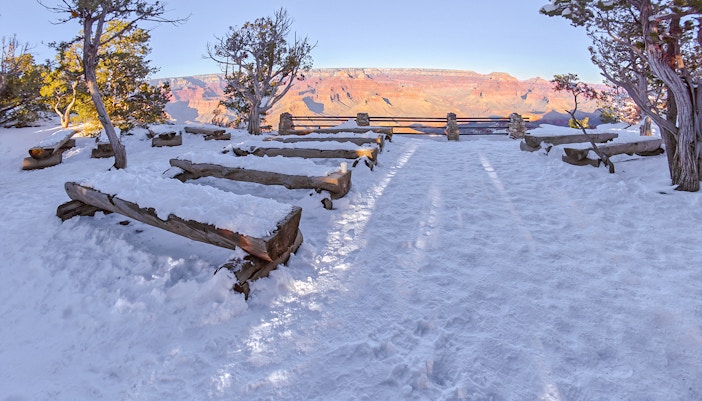
February
Average temperature: 45°F / 21°F (7°C / -6°C)
Average snowfall: 8 inches (20 cm)
February brings chilly mornings and occasional snow, but also brilliant light and a sense of solitude. The days are slightly longer, making it a favorite for off-season photographers and hikers.
Travel tip: Visit the Yavapai Geology Museum for warm indoor canyon views and fascinating exhibits.
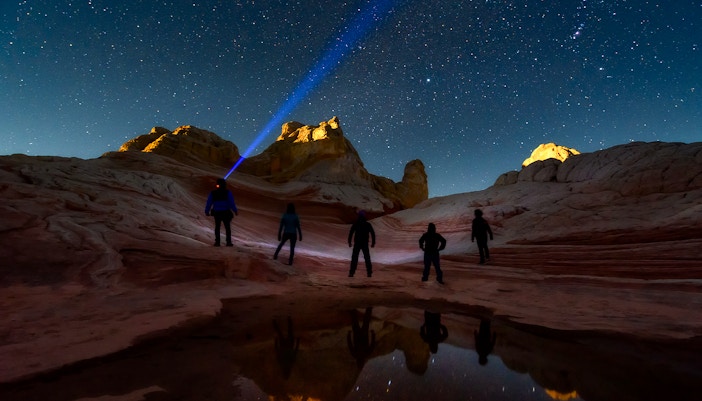
March
Average temperature: 51°F / 25°F (11°C / -4°C)
Average snowfall: 6 inches (15 cm)
Spring slowly begins in March. Snow starts to melt, trails reopen, and wildlife becomes more active. Layered clothing is essential, as temperatures swing widely.
Travel tip: Catch a ranger-led stargazing program—clear skies make for ideal night viewing.

April
Average temperature: 60°F / 32°F (15°C / 0°C)
Average rainfall: 0.8 inches (20 mm)
April is prime hiking weather, with mild temperatures and blooming wildflowers. Most South Rim facilities are fully open, and the North Rim remains closed.
Travel tip: Ride the scenic Hermit Road shuttle to access less-crowded viewpoints like Pima Point.
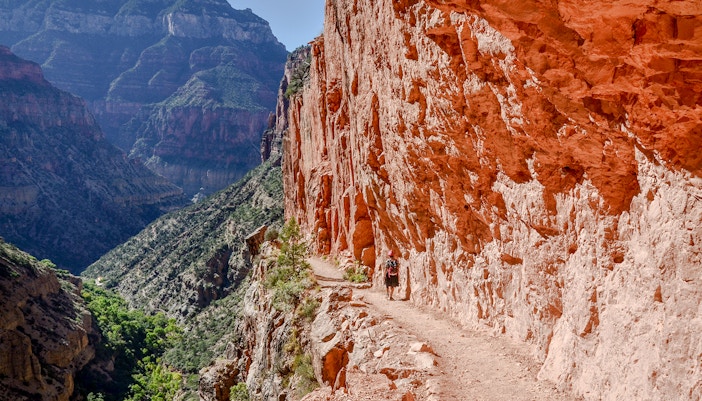
May
Average temperature: 70°F / 39°F (21°C / 4°C)
Average rainfall: 0.6 inches (15 mm)
May is one of the best months to visit. The weather is warm but not yet hot, and the North Rim reopens mid-month. Expect longer daylight and full access to trails.
Travel tip: Book accommodations early—May is popular for both hikers and road trippers.
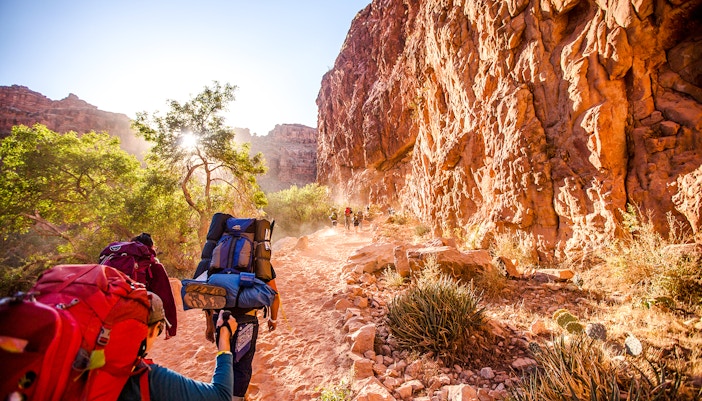
June
Average temperature: 81°F / 47°F (27°C / 8°C)
Average rainfall: 0.3 inches (8 mm)
June marks the start of summer, with dry, hot days and cooler nights. This makes it perfect for early morning hikes and rim-side picnics before midday heat sets in.
Travel tip: Start hikes before 7 am and avoid inner canyon hikes after 10 am.

July
Average temperature: 84°F / 54°F (29°C / 12°C)
Average rainfall: 1.6 inches (40 mm)
July is the hottest month, especially in the Inner Canyon, where temperatures exceed 100°F (38°C). Afternoon monsoon storms are common, brief but dramatic.
Travel tip: Pack a rain jacket and check trail conditions daily—flash floods are possible in slot canyons.

August
Average temperature: 81°F / 53°F (27°C / 12°C)
Average rainfall: 2.2 inches (56 mm)
The monsoon season continues. Mornings are pleasant, while afternoons may bring thunderheads and lightning. Still, it’s a lively month with long days and starry skies.
Travel tip: Enjoy dramatic storm photography—some of the canyon’s most dynamic skies occur now.

September
Average temperature: 75°F / 47°F (24°C / 8°C)
Average rainfall: 1.4 inches (36 mm)
September is a sweet spot—cooler temperatures return, crowds thin out, and the monsoons taper off. It's ideal for hiking, mule rides, and canyon drives.
Travel tip: Watch the sunset from Lipan Point, which has fewer crowds and a panoramic view of the Colorado River.
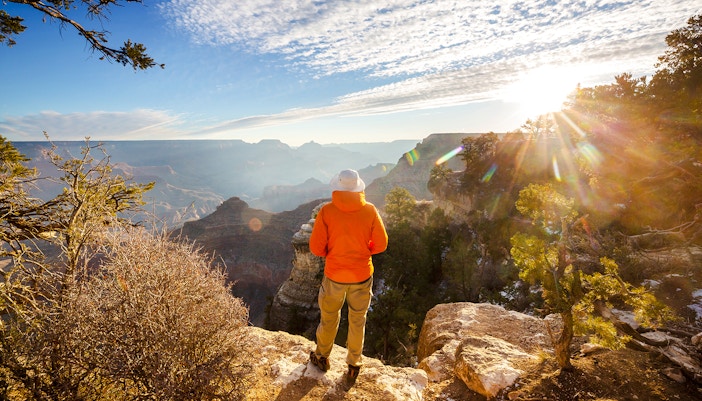
October
Average temperature: 64°F / 36°F (18°C / 2°C)
Average snowfall: 1 inch (2.5 cm)
October brings fall colors, crisp air, and incredible visibility. The North Rim closes mid-month, so it’s the last chance to experience both rims in one trip.
Travel tip: Visit early to catch changing foliage and explore rim trails in perfect weather.
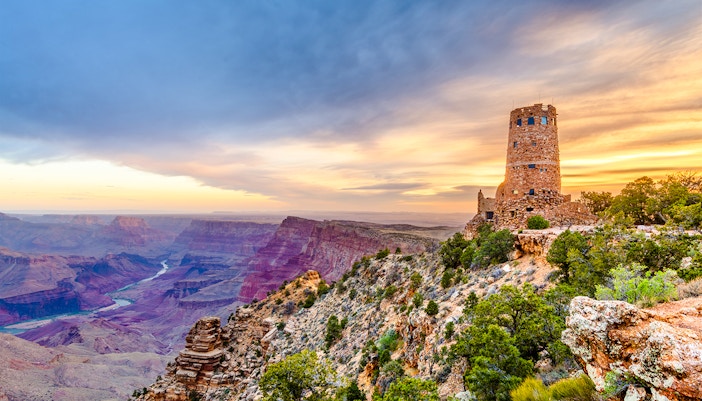
November
Average temperature: 52°F / 27°F (11°C / -3°C)
Average snowfall: 4 inches (10 cm)
November sees fewer visitors and the first real snowstorms. The South Rim stays open, and clear skies make for excellent day hikes with a winter feel.
Travel tip: Visit the Desert View Watchtower before it closes for the season, and catch golden hour views.

December
Average temperature: 43°F / 20°F (6°C / -6°C)
Average snowfall: 8 inches (20 cm)
December is a peaceful and festive month, with snow-blanketed cliffs and stunning morning light. Crowds are low, except around the holidays, and lodging is easier to find.
Travel tip: Warm up by the fireplace in historic El Tovar Lodge after a snowy sunrise walk along the rim.
Pack for the weather

🌸 Spring (March–May)
The weather can swing between chilly mornings and warm afternoons. It is advised to pack layers, including a fleece or light jacket, plus sun protection like a hat and sunscreen. Hiking boots with good traction are essential for thawing, sometimes muddy trails.
☀️ Summer (June–August)
Expect intense sun and extreme heat, especially below the rim. Pack lightweight, breathable clothing, a wide-brimmed hat, and hydration gear like a CamelBak or refillable water bottles. Rain gear is also wise during the monsoon season (July–August).
🍂 Fall (September–November)
Temperatures start to cool, especially in the mornings and evenings. Dress in layers and pack a warm jacket for sunset views. Comfortable hiking shoes and a headlamp are helpful for early starts or stargazing.
❄️ Winter (December–February)
Be prepared for snow and ice at the rim. Pack a winter coat, gloves, a hat, and waterproof boots with traction. Don’t forget sunglasses—sunlight on snow can be blinding. Layers are still key for indoor/outdoor transitions.
Book Grand Canyon tours
Frequently asked questions about the weather in the Grand Canyon
April, May, September, and October are ideal months for visiting. The weather is mild, the trails are open, and the crowds are smaller than in summer.
Not really—but July and August can be uncomfortably hot at the bottom of the canyon, and winter months can bring snow and limited access to the North Rim.
It’s possible. The South Rim is about 7,000 feet (2,134 m) high, and some visitors may feel lightheaded, tired, or short of breath—especially on the first day.
Spring or fall is perfect (April to early June or September to October). The weather’s comfortable, the trails are manageable, and it’s less crowded.
It can be if you plan well. Start early, stay hydrated, and avoid hiking between 10am and 4pm, the canyon floor can reach over 100°F (38°C).
Yes. Daily weather updates are posted at visitor centers and trailheads. You can also check the National Weather Service’s Grand Canyon page online before you go.
Yes, especially during monsoon season (July to September). If a storm is approaching, avoid high points and open areas. Head indoors or into your vehicle if you can.
It depends on where you are. The rims can be icy in winter, but the canyon floor stays warmer year-round, sometimes even hot when it’s chilly up top.
They’re quite drastic. Temperatures can shift 20–30°F (11–17°C) between the rim and the canyon floor, and conditions change fast, especially in spring or during storms. Always pack layers.
Yes, mainly in winter. Snow and ice can close roads, especially to the North Rim, which typically shuts from mid-October to mid-May. Trails may also close temporarily for safety.

